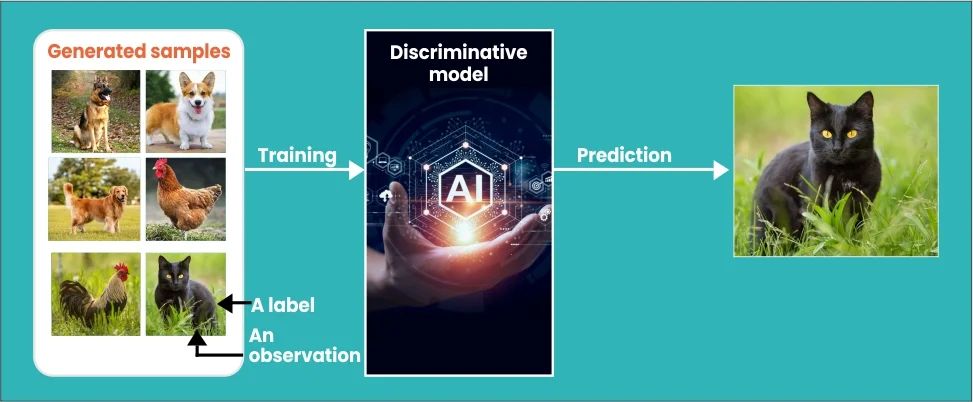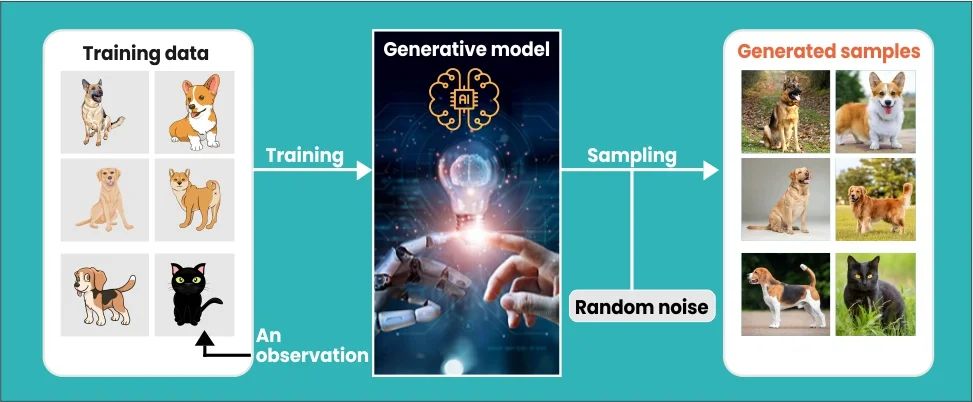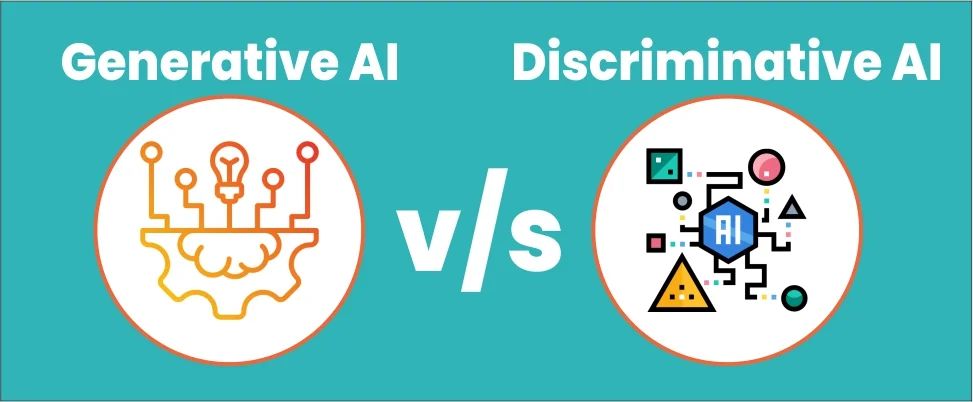Table of Contents
ToggleIntroduction
Generative model and discriminative model are two distinct AI models that serve different purposes. Discriminative models focus more on predicting the likelihood and probability of a particular class or category from the user’s input. Generative models, on the other hand, are used to generate new instances of data from similar data. Therefore, discriminative AI is used to classify and analyze data by understanding the decision boundary and distinguishing different classes of data. Generative AI models aim to understand data distribution from the given information. In this article, we will explore the key difference between generative model and discriminative model.
Understanding the Key Differences Between Generative AI and Discriminative AI
A discriminative model is like a filtering tool that helps to distinguish data from different categories or classes. It takes the input from the user and categorizes the data. In simple words, it says what something is and what it is not. Generative AI, on the other hand, is a creative and imaginary artist. It excels at generating new and unique data based on trained data patterns. Therefore, Generative AI falls under the creative category of AI models that produce new samples of data. It differs from a discriminative AI model. Discriminative AI classifies or discriminates between different data samples.
Let’s assume that we have two types of datasets, X and Y.

In this, a generative model will use the joint probability distribution p(X, Y) of the dataset to capture the whole dataset.

Whereas discriminative AI models will only capture the conditional probability distribution p(Y | X) of the dataset.

From the above image, generative AI that is trained on datasets of dog images can be used to produce more images of different kinds of dogs. However, discriminative models trained on dog images labeled with their species can be used to classify different dog breeds, as shown in the image.
Discriminative AI: Sophisticated Filter

A discriminative model helps to classify whether the image is of a dog or a cat. This type of AI model can predict a target variable based on a set of given inputs. It first learns the relationship between the input features and the target variable and then uses that relationship to make predictions. Discriminative AI models are commonly used for classification tasks and to predict which class an instance belongs to in which category. Besides, it is also used in object detection, semantic segmentation, panoptic segmentation, keypoint detection, regression problems, and language modeling.
It works by learning a decision boundary, which allows it to separate the training data points into their respective classes. First, it maps the input data to the correct label. Once it learns the decision boundary, the AI model separates one class from another and predicts the labels of the data. Outliers don’t have any effect on discriminative AI. However, the wrong classification of a data point can lead to a misclassification problem. This is one of the major drawbacks of discriminative AI. Some examples of discriminative AI are Logistic regression, Support vector machines, Decision trees, and Random Forest.
Discriminative AI: Real-life Examples
- Credit Worthiness: The finance industry relies on discriminative AI to check customer’s credit scores. It does this by analyzing the financial history of that individual, spending habits, and other factors. At last, this AI model can predict whether the individual is eligible for a loan or not.
- Facial Recognition: Nowadays, facial recognition systems are used to keep robust security features in devices like smartphones, laptops, and other devices. This helps to identify and verify only one individual with unique facial features, so another person cannot access their personal device.
- Spam Filtering in Emails: Gmail uses discriminative algorithms to filter spam and non-spam emails. It does this by analyzing patterns and features in the data. This will sort emails and ensure that the inbox is free from unwanted clutter.
Generative AI: Creative Tool

This type of AI model is used for unsupervised machine learning to perform tasks like probability and likelihood estimation and modeling data points to distinguish between classes based on these probabilities. A generative AI model trained on a dataset of cat pictures is used to generate new cat pictures.

Similarly, a generative model trained on human faces is used to generate new realistic images that are not identical to existing images.

As you can see from the image, generative AI fills different variations from the given output. Due to this, the Gen AI model must be probabilistic in nature. Generative Adversarial Networks (GANs) and Variational Autoencoders (VAEs) are the two types of generative AI models. To learn more about it in detail, check out this link.
Generative AI tools can help us understand any complex data set. Let’s say we need to find out the behavior of species. When using Generative AI, we can figure out the behaviors and learn more about them. As well, it can be used to enhance the machine learning algorithms more realistically. Therefore, it can provide better performance and more accurate results. However, these models are prone to outliers; therefore, the presence of outliers in the dataset can affect these AI models significantly. Moreover, it relies on the Bayes theorem to find the joint probability. Some examples of Gen AI are Latent Dirichlet Allocation (LDA), Bayesian Network, Hidden Markov Model, Autoregressive Model, and Generative Adversarial Network.
Generative AI: Real-Life Examples
- Art Creation: Popular music platforms like Jukedeck and Amper Music leverage the potential of generative AI to compose fresh new music. Similarly, many artists use AI tools to create something entirely different and awe-inspiring from existing styles.
- Entertainment Industry: Generative AI can help cut down on the hefty costs of the entertainment industry. As it can help them write unique scripts, apply impressive visual effects, improve the sound design, and brainstorm ideas for marketing.
- Synthetic Data: Generative AI can help secure confidential and sensitive data by creating synthetic datasets that mimic real data. Hence, synthetic data helps to train an AI model and make it robust without using sensitive or confidential data.
Generative AI vs. Discriminative AI: Key Difference
| Factors | Generative AI | Discriminative AI |
|---|---|---|
| Focus | Focuses on providing insights by going through the underlying data distribution and structure. | Primarily focuses on boundaries and differences between classes. |
| Mathematical Intuition | It maximizes the conditional probability P(Y|X). | By maximizing the joint probability of P(X, Y). |
| Objective | The joint probability distribution P(x, y) or likelihood of P(x). | The conditional probability P(y). |
| Computational Cost | It requires more data to better understand the data and extract meaningful insights. | With less data, it can perform well with classification tasks. |
| Parameter Count | It has a larger parameter count as it takes the entire data distribution. | Since it only focuses on the decision boundary, it takes only a few parameters. |
| Sample Generation | It can generate new data samples based on the trained data. | It cannot generate new samples but excels in tasks like image classification, sentiment analysis, speech recognition, and object detection. |
| Application | It is used for data generation, filling up missing data, density estimation, and many more. | Primarily used for classifying existing data, such as image classification and spam filtering. |

Don't miss out on your chance to work with the best
apply for top global job opportunities today!
Generative AI vs. Discriminative AI: Which AI is the Best?
Both the discriminative model and generative model are the best in their respective domains. These two AI models learn about the relationship between inputs and outputs. While generative models must learn about data distribution, discriminative models learn about the decision boundary between classes. But when it comes to training the AI model, discriminative AI is faster and easier to train than generative AI. Also, it provides more accurate results than generative models. Having said that, it is not best suited for tasks where the underlying data distribution is complex or uncertain.
In this regard, generative AI has the upper hand and has the additional benefit of generating new data samples, due to which it can be particularly useful for data augmentation tasks. Apart from this, generative models are also beneficial for various tasks, like image and text generation, but they require more training data and computational resources. All in all, both fields are remarkable in their respective domains; the best one depends on the goals of the machine-learning project. If you’re having difficulty, then here are a few things to consider before choosing between these two AI models:
- Less Data Availability: If you are working on a project with a limited amount of labeled data, a generative AI model will be the best choice for you. This Gen AI comes under the unsupervised machine learning algorithm and learns the underlying data distribution from unlabeled data with ease.
- High-Complexity Task: In this regard, the discriminative AI model is the perfect choice. Discriminative models are by far the best at making accurate predictions.
- Meaningful Insights: Generative AI is perfect for this task. So, if you are working on some data and need to understand the underlying data distribution, then generative AI is the perfect choice for you.
Take control of your career and land your dream job
sign up with us now and start applying for the best opportunities!

FAQs
No, it’s not. A convolutional neural network (CNN) is a neural network used for image classification. .
Yes, we can, but its main goal is to predict the class label of an input based on some features.
It is a generative AI model that generates text based on patterns it has learned from vast amounts of data.
Probability’s primary focus is on the underlying probability distribution of the data. Discriminative models, on the other hand, focus on deciding between classes.
Some of the ethical considerations when using generative AI are data privacy, bias answers, copyright issues, and lack of transparency.
Generative AI can help in the creation of novel chemical structures and reduce trial error.

